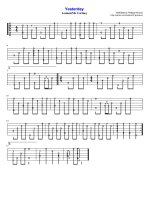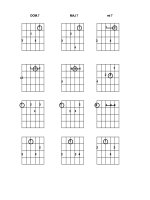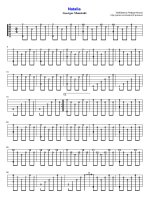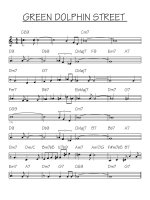odour control design tủ tài liệu bách khoa
Bạn đang xem bản rút gọn của tài liệu. Xem và tải ngay bản đầy đủ của tài liệu tại đây (202.04 KB, 24 trang )
Wastewater Collection System Odor Control
Design Guidelines:
Odor Impact and Vapor-Phase Control and
Sulfide Generation and Liquid-phase Control
Odor Impact and Vapor-Phase Control
Objective
These guidelines are intended to provide a step-by-step method for estimating
pressurization at siphons and wet wells, off-site odor potential, and any vapor-phase control
which may be necessary. The calculations herin shall be followed to establish the maximum
off-site hydrogen sulfide concentration and to determine if treatment of gasses is necessary.
Once the calculations are complete, they shall be submitted to the City of San Marcos
Engineering Director for review.
Overview
The steps presented herein provide a screening approach to estimate the potential for outgassing, off-site odor impacts, and vapor-phase control. Step-by-step instructions are
provided followed by an example illustrating the process. A form is provided to guide
calculations.
Data Needs
Table 1 lists the data that will be needed for the calculations.
TABLE 1
Data needs
Data Needs
Symbol
value
Units
Average wastewater flow rate
Q
MGD
Wastewater pH
pH
-
Incoming sulfide concentration
Sout
mg/L
Wastewater temperature
T
ºC
Upstream pipe diameter
Dup
in
Upstream pipe slope
SLup
ft/ft
Downstream pipe diameter
Ddown
in
Downstream pipe slope
SLdown
ft/ft
Out-gassing structure volume
V
ft3
Sensitive receptor distance from odor source
F
ft
Estimate H2Sg Concentration
Step 1: Henry’s law constant
Calculate Henry’s law constant based on temperature as shown in Equation 1.
H = 0.0084T + 0.2043
•
•
(1)
H = Henry’s Law constant for H2S, (unitless)
T = Wastewater temperature (ºC)
Step 2: Liquid H2S concentration
Use Figure 1 to estimate the FractionH2Sliq based on pH.
FIGURE 1
Fraction, based on pH, of incoming sulfide that is in the form of H2Sliq
1
0.9
0.8
Fraction as H2Sliq
0.7
0.6
0.5
0.4
0.3
0.2
0.1
0
4
5
6
7
8
9
10
pH
Calculate the equilibrium liquid H2S concentration based on FractionH2Sliq and the incoming
sulfide concentration, Sout (mg/L), as shown in Equation 2.
H 2 Sliq = Sout × FractionH2 Sliq
•
•
•
(2)
FractionH2Sliq = portion of dissolved sulfide in the form of H2S at equilibrium (mg/L)
Sout = incoming sulfide concentration (mg/L)
H2Sliq = incoming liquid H2S concentration (mg/L)
Step 3: H2S gas concentration
Calculate equilibrium hydrogen sulfide gas concentration based on Henry’s Law as shown
in Equation 3.
H 2 S gas = H × H 2 S liq
(3)
2
•
•
H2Sgas = equilibrium hydrogen sulfide gas concentration (mg/L)
H = Henry’s Law constant for hydrogen sulfide (unitless)
Step 4: H2S gas in ppmv
Convert H2Sgas from units of mg/L to ppmv as shown in Equation 4. H2Sgas is the
concentration that would be at equilibrium with the in-coming liquid sulfide concentration
and should be considered a conservative (high) estimate for the incoming hydrogen sulfide
gas concentration.
H 2 S g = H 2 S gas × (T + 273) × 2.41
•
(4)
H2Sg = the equilibrium hydrogen sulfide concentration (ppmv)
Calculate Upstream and Downstream Natural Ventilation
Ventilation in the upstream and downstream pipe due to liquid drag (natural ventilation)
can be estimated based on hydraulic conditions in the pipes.
Step 5: Upstream natural ventilation
Use Figures 2, 3, 4, and 5 for 36, 24, 12, and 8-inch diameter pipes, respectively, to estimate
the natural ventilation, Qairup (cfm) in the pipe discharging into the structure where outgassing is expected. If the upstream pipe slope and diameter is not represented by one of
the curves, interpolate between the two nearest curves.
FIGURE 2:
Air flow as a function of water flow in a 36 inch pipe
Air flow vs. water flow 36" pipe
600
Slope = 0.02
540
480
Slope = 0.01
Air flow (cfm)
420
Slope = 0.005
360
300
Slope = 0.0025
240
180
Slope = 0.001
120
60
0
1
3
5
7
9
11
13
15
Water flow (mgd)
3
FIGURE 3:
Air flow as a function of water flow in a 24 inch pipe
Air flow vs. water flow 24" pipe
225
Slope = 0.02
200
175
Slope = 0.01
Air flow (cfm)
150
125
Slope = 0.005
100
75
Slope = 0.0025
50
Slope = 0.001
25
0
0
1
2
3
4
5
6
7
8
9
Water flow (mgd)
FIGURE 4:
Air flow as a function of water flow in a 12 inch pipe
Air flow vs. water flow 12" pipe
40
36
32
Air flow (cfm)
28
24
Slope = 0.02
20
16
Slope = 0.01
12
Slope = 0.005
8
Slope = 0.001
Slope = 0.0025
4
0
0
0.5
1
1.5
2
Water flow (mgd)
2.5
3
3.5
4
Figure 5:
Air flow as a function of water flow in an 8 inch pipe
Air flow vs. water flow 8" pipe
16.0
Slope = 0.02
Air flow (cfm)
12.0
8.0
Slope = 0.01
Slope = 0.005
4.0
Slope = 0.001
Slope = 0.0025
0.0
0
0.1
0.2
0.3
0.4
0.5
0.6
0.7
0.8
0.9
1
Water flow (mgd)
Step 6: Downstream natural ventilation
Use the approach in step five to estimate the downstream natural ventilation, Qairdown (cfm).
For a siphon or other complete bottleneck, downstream natural ventilation will have no
bearing on out-gassing and is zero for this purpose.
Step 7: Out-gas flow rate
Calculate the out-gassing flow rate, Qoutgas (cfm), as shown Equation 5.
Qoutgas = Qairup − Qairdown
•
•
•
(5)
Qoutgas = The flow rate of air exiting a sewer structure due to pressurization (cfm)
Qairup = Natural ventilation in the upstream pipe (cfm)
Qairdown = Natural ventilation in the downstream pipe (cfm)
Step 8: Hydrogen sulfide emission
Calculate the hydrogen sulfide emission rate as shown in Equation 6.
E H 2 S = Qoutgas ×
•
m3 s
× H 2 S gas
2119cfm
(6)
EH2S = Hydrogen sulfide emission from the bottleneck (g/s)
5
Estimate the Down-wind Odor Impact
EPA dispersion model Screen 3 was used to estimate down-wind hydrogen sulfide
concentration per unit emission.
Step 9: Down-wind concentration per unit emission
Use Figure 6 to determine the worst-case H2Sunit ((ppmv)/(g/s)) based on the distance from
the out-gassing location to the nearest sensitive receptor, F (ft).
FIGURE 6
Worst-case hydrogen sulfide concentration per unit emission as a function of distance from the odor source.
1000
700
500
300
H2Sunit ((ppmv)/(g/s))
100
70
50
30
10
7
5
3
1
0.7
0.5
0.3
0.1
0
300
600
900
1200
1500
1800
2100
Distance from odor source (ft)
Step 10: Down-wind worst-case concentration
Calculate down-wind worst-case H2S concentration as shown in Equation 7.
H 2 S receptor = E H 2 S × H 2 S unit
•
(7)
H2Sreceptor = the worst-case projected hydrogen sulfide concentration at the receptor of
concern due to the emission from the odor source, (ppmv)
Step 11: Offsite impact criteria
Compare H2Sreceptor to the maximum acceptable off-site hydrogen sulfide concentration. If it
is less, no treatment is needed. If it is more, go to step 12.
6
Determine the forced air flow rate needed for gas-phase treatment
Step 12: Air change criteria
Calculate the volumetric air flow rate, Qaer (cfm), needed to provide 12 air changes per hour
in the wet well or odor source structure as shown in Equation 8.
Qaer =
•
•
12
hr
×V ×
hr
60 min
(8)
Qaer = Structure ventilation rate needed to provide 12 air changes per hour (cfm)
V = Volume of the wet well of odor source structure (ft3)
Step 13: Forced air-flow rate selection
The wet well or odor source structure ventilation rate needed for gas-phase treatment is the
greater of Qaer and 2 x Qoutgas.
Example
Data Needs
Table 1 lists the data that will be needed for the calculations.
TABLE 1
Data needs
Data Needs
Symbol
value
Units
Average wastewater flow rate
Q
6.85
mgd
Wastewater pH
pH
7.1
-
Incoming sulfide concentration
Sout
3.0
mg/L
Wastewater temperature
T
24
ºC
Upstream pipe diameter
Dup
30
in
Upstream pipe slope
SLup
0.005
ft/ft
Downstream pipe diameter
Ddown
30
in
Downstream pipe slope
SLdown
0.003
ft/ft
Out-gassing structure volume
V
800
ft3
Sensitive receptor distance from odor source
F
150
ft
Estimate H2Sg Concentration
Step 1: Henry’s law constant
Calculate Henry’s law constant based on temperature as shown in Equation 1.
T = 24 ºC
H = (0.0084 × 24) + 0.2043 = 0.4059
(1)
Step 2: Liquid H2S concentration
Use Figure 1 to estimate the FractionH2Sliq based on pH.
pH = 7.1
7
FIGURE 1
Fraction, based on pH, of incoming sulfide that is in the form of H2Sliq
1
0.9
0.8
Fraction as H2Sliq
0.7
0.6
0.5
0.48
0.4
0.3
0.2
0.1
0
4
5
6
7
7.1
8
9
10
pH
From Figure 1, H2Sliq = 0.48
Calculate the equilibrium liquid H2S concentration based on FractionH2Sliq and the incoming
sulfide concentration, Sout (mg/L), as shown in Equation 2.
H2Sliq = 3.0 mg/L × 0.48 = 1.44 mg/L
(2)
Step 3: H2S gas concentration
Calculate equilibrium hydrogen sulfide gas concentration based on Henry’s Law as shown
in Equation 3.
H2Sgas = 0.4059 × 1.44mg/L = 0.5845 mg/L
(3)
Step 4: H2S gas in ppmv
Convert H2Sgas from units of mg/L to ppmv as shown in Equation 4.
H2Sg = 0.5845mg/L × (24 + 273) × 2.41 = 418 ppmv
(4)
Calculate Upstream and Downstream Natural Ventilation
Step 5: Upstream natural ventilation
Interpolate between Figures 2, and 3 for 30 inch diameter pipe to estimate the natural
ventilation, Qairup (cfm) in the pipe discharging into the structure where out-gassing is
expected.
Q = 6.85 MGD
8
FIGURE 2:
Air flow as a function of water flow in a 36 inch pipe
Air flow vs. water flow 36" pipe
600
Slope = 0.02
540
480
Slope = 0.01
Air flow (cfm)
420
Slope = 0.005
360
325
300
Slope = 0.0025
240
180
Slope = 0.001
120
60
0
1
3
6.85
7
5
9
11
13
15
Water flow (mgd)
FIGURE 3:
Air flow as a function of water flow in a 24 inch pipe
Air flow vs. water flow 24" pipe
225
Slope = 0.02
200
175
Slope = 0.01
Air flow (cfm)
150
125
Slope = 0.005
105
100
75
Slope = 0.0025
50
Slope = 0.001
25
0
0
1
2
3
4
5
6
6.85
7
8
9
Water flow (mgd)
Qairup = (325 + 105)/2 = 215 cfm
9
Step 6: Downstream natural ventilation
Use the same approach as in Step 5 to estimate the downstream natural ventilation, Qairdown
(cfm). Interpolate between Figures 2, and 3 for 30 inch diameter pipe to estimate the natural
ventilation, Qairdown (cfm) in the pipe flowing out of the structure where out-gassing is
expected. Interpolate between the 0.0025 slope curve and the 0.005 slope curve.
FIGURE 2:
Air flow as a function of water flow in a 36 inch pipe
Air flow vs. water flow 36" pipe
600
Slope = 0.02
540
480
Slope = 0.01
Air flow (cfm)
420
Slope = 0.005
360
300
280
Estimate
0.003 slope
line
240
Slope = 0.0025
180
Slope = 0.001
120
60
0
1
3
5
6.85
7
9
11
13
15
Water flow (mgd)
10
FIGURE 3:
Air flow as a function of water flow in a 24 inch pipe
Air flow vs. water flow 24" pipe
225
Slope = 0.02
200
175
Slope = 0.01
Air flow (cfm)
150
125
Slope = 0.005
100
Slope = 0.0025
75
57
50
Estimate
0.003 slope
line
Slope = 0.001
25
0
0
1
2
3
4
5
6
6.85 7
8
9
Water flow (mgd)
Qairdown = (280 + 57)/2 = 169 cfm
Step 7: Out-gas flow rate
Calculate the out-gassing flow rate, Qoutgas (cfm), as shown Equation 5.
Qoutgas = 215 − 169 = 46 cfm
(5)
Step 8: Hydrogen sulfide emission
Calculate the hydrogen sulfide emission rate as shown in Equation 6.
E H 2 S = 46cfm ×
m3 / s
× 0.5845mg / L = 0.013 g/s
2119cfm
(6)
Estimate the Down-wind Odor Impact
Step 9: Down-wind concentration per unit emission
Use Figure 6 to determine the worst-case H2Sunit ((ppmv)/(g/s)) based on the distance from
the out-gassing location to the nearest sensitive receptor, F (ft).
F = 150 ft
11
FIGURE 6
Worst-case hydrogen sulfide concentration per unit emission as a function of distance from the odor source.
1000
700
500
300
H2Sunit ((ppmv)/(g/s))
100
70
50
30
12
10
7
5
3
1
0.7
0.5
0.3
0.1
0
150
300
600
900
1200
1500
1800
2100
Distance from odor source (ft)
From Figure 6, H2Sunit = 12 (ppmv)/(g/s)
Step 10: Down-wind worst-case concentration
Calculate down-wind worst-case H2S concentration as shown in Equation 7.
H 2 S receptor = 0.013 g / s × 12
ppmv
g / s = 0.16 ppmv
(7)
Step 11: Offsite impact criteria
Compare H2Sreceptor to the maximum acceptable off-site hydrogen sulfide concentration. If it
is less, no treatment is needed. If it is more, go to step 12.
0.16 ppmv is approximately 200 times the human detection threshold. Therefore, treatment
may be needed.
Determine the forced air flow rate needed for gas-phase treatment
Step 12: Air change criteria
Calculate the volumetric air flow rate, Qaer (cfm), needed to provide 12 air changes per hour
in the wet well or odor source structure as shown in Equation 8.
Qaer =
hr
12
× 800 ft 3 ×
hr
60 min = 160 cfm
(8)
12
Step 13: Forced air-flow rate selection
The wet well or odor source structure ventilation rate needed for vapor-phase treatment is
the greater of Qaer and Qoutgas
2 x Qoutgass = 2 x 46 cfm = 92 cfm < Qaer = 160 cfm. Therefore, 160 cfm or greater would need
to be treated.
13
Odor Impact Potential and Preliminary Vapor Phase Treatment Assessment
Project Name:_________________________________________________________________________________________________________
Project Location:_______________________________________________________________________________________________________
Data Needs
#
Formula
Average wastewater flow rate (Q)
1
Given in Table 1
mgd
Wastewater pH (pH)
2
Given in Table 1
-
Incoming sulfide concentration (Sout)
3
Given in Table 1
mg/L
Wastewater temperature (T)
4
Given in Table 1
ºC
Upstream pipe diameter (Dup)
5
Given in Table 1
in
Upstream pipe slope (SLup)
6
Given in Table 1
ft/ft
Downstream pipe diameter (Ddown)
7
Given in Table 1
in
Downstream pipe slope (SLdown)
8
Given in Table 1
ft/ft
Out-gassing structure volume (V)
9
Given in Table 1
ft3
Sensitive receptor distance from odor source (F)
10
Given in Table 1
ft
11
= 0 . 0084 × # 4 + 0 . 2043 =
-
Fraction of dissolved sulfide as H2Sliq (FractionH2Sliq)
12
Use #2 and read from Figure 1
-
Liquid-phase H2S concentration (H2Sliq)
13
= # 3× #12 =
mg/L
Equilibrium vapor-phase H2S concentration (H2Sgas)
14
= #11 × #13 =
mg/L
Equilibrium vapor-phase H2S concentration (H2Sg)
15
= #14 × (# 4 + 273 ) × 2 . 41 =
ppmv
Henry’s Law constant (H)
Value
units
Calculation Form Con’t
Upstream natural Ventilation (Qairup)
Downstream natural Ventilation (Qairdown)
Out-gas flow rate (Qoutgas)
16
Use #1, #5, and #6, and read value from Figures 2, 3 or 4.
Interpolate, if necessary.
cfm
17
Use #1, #7, and #8, and read value from Figures 2, 3, 4, or 5.
Interpolate, if necessary.
cfm
18
= #16 − #17 =
cfm
Hydrogen sulfide emission rate (EH2S)
19
Worst case H2S concentration per unit emission at
receptor (H2Sunit)
20
Worst case H2S concentration at receptor
(H2Sreceptor)
21
= #18 ×
m3 / s
× #14 =
2119 cfm
Use #10 to read value from Figure 6
= #19 × # 20 =
g/s
ppmv/(g
/s)
ppmv
If yes, then no treatment is necessary – Stop here
Is #21 acceptable?
If no, then treatment is necessary - Continue
Volumetric air flow rate required to ventilate structure
with 12 air changes per hour (Qaer)
22
=
12
hr
× #9 ×
=
hr
60 min
cfm
The required foul air treatment flow rate will be #22 or two times #18, which ever is larger.
15
Sulfide Generation and Liquid-phase Control
Objective
These guidelines are intended to provide a step-by-step method for estimating sulfide
generation in force mains and siphons, liquid-phase chemical dose requirements, oxygen
injection, and costs for controlling sulfide. The calculations shall be followed to establish the
maximum sulfide generation and to determine if treatment of sulfide is necessary, as well as
determine the approximate cost of treatment. Once the calculations are complete, they shall
be submitted to the City of San Marcos Engineering Director for review.
Overview
The steps presented herein provide a screening approach to estimate sulfide generation in
force mains and siphons, approximate chemical dosing required to control sulfide, oxygen
injection required to control sulfide, and associated planning level costs. Step-by-step
instructions are provided followed by an example illustrating the process. A form is
provided to guide calculations.
Data Needs
Table 1 lists the data that will be needed for the calculations.
TABLE 1
Data needs
Data Needs
Symbol
value
Units
Summer wastewater temperature
Tsum
ºC
Winter wastewater temperature
Twin
ºC
BOD5
mg/L
Average wastewater flow rate
Q
mgd
Pipe diameter
D
in
Pipe length
L
ft
Sin
mg/L
SThresh
mg/L
Five-day biochemical chemical oxygen demand
Dissolved sulfide at the upstream end of the pipe
Threshold sulfide concentration
Calculate Sulfide Generation
Step 1: Force main/Siphon retention time
Calculate retention time, R (min), according to Equation 1.
R=
•
•
L πD 2 7.48 × 10 −5 mgal ⋅ min
×
×
Q
4
in 2 ⋅ ft ⋅ day
R = Pipe retention time (min)
L = Pipe length (ft)
(1)
•
•
Q = average wastewater flow rate (mgd)
D = Pipe diameter (in)
Step 2: Effective BOD
Calculate the temperature adjusted effective biochemical oxygen demand, BODeff (mg/L), as
shown in Equation 2. Calculate BODeff for summer and winter wastewater temperatures.
BODeff = BOD5 × 1.07 (T − 20
•
•
•
o
(2)
C)
BODeff = BOD adjusted for temperature (mg/L)
BOD5 = Five day BOD at 20 ºC (mg/L)
T = Wastewater temperature (ºC)
Step 3: Downstream sulfide concentration
Calculate liquid sulfide at the downstream end of the pipe for summer and winter BODeff as
shown in Equation 3. This calculation conservatively assumes zero initial upstream
dissolved oxygen (DOin).
⎡ 100in + D ⎤
S out = ⎢
⎥ × BODeff × R + S in
⎣ 100,000 D ⋅ min ⎦
•
•
(3)
Sout = Sulfide concentration at the downstream end of the pipe (mg/L)
Sin = Sulfide measured entering the pipe (mg/L)
Step 4: Threshold comparison
If Sout is less than the target threshold concentration, Sthresh (mg/L) for summer conditions,
then no chemicals are needed to control sulfide. Two typical target threshold concentrations
are 0.5 and 1 mg/L. The lower the value, the lower the risk of having odor complaints.
However, as the threshold value is decreased, annual operating costs associated with
chemical consumption increase.
Step 5: Chemical selection
If Sout is greater than Sthresh, select a chemical and dose from Table 2.
TABLE 2
Liquid phase chemical dose and cost for controlling sulfide
Chemical
Dose1 (gal / lb sulfide)
Cost2 ($/gal)
Hydrogen Peroxide (50% solution)
0.6
3.4
Iron Salts (30% FeCl2 solution)
2.7
0.7
Bioxide
1.3
2
Pure Oxygen (supplied to tank)
N/A
From Vendor
1.
Doses shown are typical for municipal wastewater. Actual doses could be
larger or smaller than the values shown.
17
TABLE 2
Liquid phase chemical dose and cost for controlling sulfide
Dose1 (gal / lb sulfide)
Chemical
Cost2 ($/gal)
Hydrogen Peroxide (50% solution)
0.6
3.4
Iron Salts (30% FeCl2 solution)
2.7
0.7
2.
Costs shown in Table 2 are provided for screening purposes. Actual
current costs and availability should be verified with vendors.
Calculate Chemical Cost
Step 6: Daily sulfide load
Calculate the daily sulfide load (lb sulfide/day) for summer and winter Sout as shown in
Equation 4.
Load = Q × S out ×
•
8.35 L ⋅ lb
mgal ⋅ mg
(4)
Load = Daily sulfide load exiting the pipe (lb/day)
Q = Average wastewater flow rate (mgd)
Step 7: Yearly chemical cost
Use the dose and cost of the selected chemical to calculate chemical cost per year by using
the average of the summer and winter sulfide loads as shown in Equation 5. This step
conservatively assumes that the entire load will be treated to a target of zero sulfide rather
than the threshold target.
ChemicalCo st / year =
Load w int er + Load summer 365days
×
× Dose × Cost
yr
2
(5)
Calculate the oxygen needed to control sulfide
Sulfide can be prevented from forming in a siphon or forcemain by injecting air or oxygen at
the upstream end of the force main. The DOin needed to keep the entire force main aerobic
will depend on R and BODeff. An oxygen concentration of 1.0 mg/L or greater is sufficient
to prevent sulfide generation.
Step 8: Upstream oxygen concentration needed
Use Equation 6 to calculate DOin needed to maintain a DO greater than 1.0 mg/L at the
downstream end of the pipe. Use BODeff for the summer temperature.
DOinneeded =
BODeff
hr
2.8mg / L
1.0mg
×
× R×
+
hr
L
200mg / L
60 min
(6)
18
DOinneeded = Dissolved oxygen concentration needed in the upstream end to maintain aerobic
conditions throughout the pipe (mg/L)
Step 9: Oxygen injection rate
Calculate the oxygen injection rate, G (g/min) needed to provide the DOinneeded as shown in
Equation 7.
G=
•
•
needed
Q × DOin
η diff
×
2.63L ⋅ day ⋅ g
mg ⋅ mgal ⋅ min
(7)
G = the pure oxygen injection rate (g/min)
ηdiff = Diffuser efficiency (gas dissolved/gas injected)
Use a default value of 0.8 for ηdiff until information on the diffuser equipment is available.
Step 10: Yearly oxygen cost
Calculate yearly oxygen cost as shown in Equation 8.
OxygenCost / year = G ×
•
526kg ⋅ min
× CostO2
g ⋅ yr
(8)
CostO2 = Delivered oxygen unit cost ($/kg)
Compare Options
Compare costs for O2 injection and chemical treatment to estimate the lowest cost option.
19
Example
Data Needs
TABLE 1
Data needs
Data Needs
Symbol
Value
Units
Summer wastewater temperature
Tsum
27
ºC
Winter wastewater temperature
Twin
18
ºC
BOD5
260
mg/L
Average wastewater flow rate
Q
0.144
mgd
Pipe diameter
D
12
in
Pipe length
L
2000
ft
Sin
0.6
mg/L
SThresh
1.0
mg/L
Five-day biochemical chemical oxygen demand
Dissolved sulfide at the upstream end of the pipe
Threshold sulfide concentration
Calculate Sulfide Generation
Step 1: Force main/Siphon retention time
L = 2,000 ft
Q = 0.144 mgd
D = 12 in
R=
2,000 π (12)2 7.48 × 10 −5 mgal ⋅ min
×
×
= 118 min
0.144
4
in 2 ⋅ ft ⋅ day
Step 2: Effective BOD
Tsum = 27 ºC
Twin = 18 ºC
SummerBODeff = 260mg / L × 1.07 ( 27 − 20
o
W int erBODeff = 260mg / L × 1.07 (18− 20
C)
o
C)
= 418mg / L
= 227 mg / L
Step 3: Downstream sulfide concentration
Summer BODeff = 418 mg/L
Winter BODeff = 227 mg/L
20
Sin = 0.6 mg/L
R = 117.5 mg/L
D = 12 in
⎡
⎤
100in + 12in
SummerS out = ⎢
⎥ × 418mg / L × 117.5 min + 0.6mg / L = 5.2mg / L
⎣ 100,000 × 12in ⋅ min ⎦
⎡
⎤
100in + 12in
W int erS out = ⎢
⎥ × 227 mg / L × 117.5 min + 0.6mg / L = 3.1mg / L
⎣ 100,000 × 12in ⋅ min ⎦
Step 4: Threshold comparison
Summer Sout = 5.2 mg/L > 1.0 mg/L = Sthresh. Therefore treatment needed.
Step 5: Chemical selection
Try iron salts
TABLE 2
Liquid phase chemical dose and cost for controlling sulfide
Dose (gal / lb
Chemical
sulfide)
Hydrogen Peroxide (50% solution)
0.6
Iron Salts (30% FeCl2 solution)
2.7
Sodium Hypochlorite (12% solution)
10
Bioxide
1.3
Pure Oxygen (supplied to tank)
N/A
Cost ($/gal)
3.4
0.7
1.0
2
From Vendor
Calculate Chemical Cost
Step 6: Daily sulfide load
Q = 0.144 mgd
Summer Sout = 5.2 mg/L
Winter Sout = 3.1 mg/L
Load = 0.144 mgd × 5.2mg / L ×
8.35 L ⋅ lb
= 6.25lb / day
mgal ⋅ mg
Load = 0.144 mgd × 3.1mg / L ×
8.35 L ⋅ lb
= 3.73lb / day
mgal ⋅ mg
Step 7: Yearly chemical cost
Dose = 2.7 gal/lb
Cost = $0.7/gal
21
Summer Load = 6.25 lb/day
Winter Load = 3.73 lb/day
ChemicalCo st / year =
(6.25 + 3.73)lb / day × 365days × 2.7 gal × $0.7 = $3442 / yr
2
yr
lb
gal
Calculate the oxygen needed to control sulfide
Step 8: Upstream oxygen concentration needed
Summer BODeff = 418 mg/L
R = 117.5 min
DOinneeded =
2.8mg / L 418mg / L
hr
1.0mg
×
× 117.5 min×
+
= 12.5mg / L
hr
200mg / L
60 min
L
Step 9: Oxygen injection rate
DOinneeded = 12.5 mg/L
Q = 0.144 mgd
η diff = 0.8
G=
0.144 × 12.5mg / L 2.63L ⋅ day ⋅ g
×
= 5.92 g / min
mg ⋅ mgal ⋅ min
0.8
Step 10: Yearly oxygen cost
Oxygen cost = $1.00/kg (this is a guess)
G = 5.92 g/min
OxygenCost / year = 5.92 g / min×
526kg ⋅ min
× $1.00 / kg = $3114 / yr
g ⋅ yr
Compare Options
$3,114 < $3,442. Therefore oxygen may be less expensive depending on capital costs.
22
Liquid Phase Sulfide Generation Potential and Preliminary Control Assessment
Project Name:
Project Location:
Data Needs
#
Formula
Summer wastewater temperature (Tsum)
1
Data provided
ºC
Winter wastewater temperature (Twin)
2
Data provided
ºC
Five-day biochemical chemical oxygen demand (BOD5)
3
Data Provided
mg/L
Average wastewater flow rate (Q)
4
Data Provided
mgd
Pipe diameter (D)
5
Data Provided
in
Pipe length (L)
6
Data Provided
ft
Dissolved sulfide at the upstream end of the pipe (Sin)
7
Data Provided
mg/L
Threshold sulfide concentration (SThresh)
8
As Provided by COSM
mg/L
Pipe Retention Time (R)
9
Temperature adjusted Summer BOD (Summer BODeff)
=
7 .48 × 10 − 5 mgal ⋅ min
# 6 π (# 5 )2
=
×
×
#4
4
in 2 ⋅ ft ⋅ day
Value
Units
min
10
o
= # 3 × 1 . 07 (# 1 − 20 C ) =
mg/L
11
o
= # 3 × 1 . 07 (# 2 − 20 C ) =
mg/L
Summer sulfide concentration exiting the downstream
end of the pipe (Summer Sout)
12
⎡
⎤
100 in + # 5
S = ⎢
⎥ × #10 × # 9 + # 7
⎣ 100 , 000 × # 5 ⋅ min ⎦
mg/L
Winter sulfide concentration exiting the downstream end
of the pipe (Winter Sout)
13
Summer sulfide load exiting the downstream end of the
pipe (Summer Load)
14
Temperature adjusted Winter BOD (Winter BODeff)
⎡
100 in + # 5
= ⎢
⎣ 100 , 000 × # 5 ⋅ min
= # 4 × # 12 ×
⎤
⎥ × #11× # 9 + # 7 =
⎦
8 . 35 L ⋅ lb
=
mgal ⋅ mg
mg/L
lb/day
Data Needs
#
Winter sulfide load exiting the downstream end of the
pipe (Winter Load)
Formula
= # 4 × # 13 ×
15
Value
8 . 35 L ⋅ lb
=
mgal ⋅ mg
Units
lb/day
If no, then no treatment is necessary – Stop here
Is Summer #12 > #8?
If yes, then treatment is necessary - Continue
Select a chemical from Table 2
Peroxide, Iron, Sodium Hypochlorite, or Bioxide
Chemical Dose
16
From Table 2 or Vendor
gal / lb sulfide
Chemical Cost
17
From Table 2 or Vendor
$/gal
Chemical Cost per year to control sulfide
(Chemical Cost/yr)
18
Dissolved oxygen concentration needed at upstream end
needed
of pipe to control sulfide ( DOin
19
)
Pure oxygen injection rate needed to provide assuming
0.8 diffuser efficiency (G)
20
Oxygen cost (CostO2)
21
Yearly cost to provide pure oxygen (O2 Cost/yr)
22
=
=
#15 + #14 365 days
×
× #16× #17 =
2
yr
2.8mg / L
#10
hr
1.0mg
×
×R×
+
=
hr
200mg / L
60 min
L
=
# 4 × #19
2 . 63 L ⋅ day ⋅ g
×
=
0 .8
mg ⋅ mgal ⋅ min
Obtain price from Vendor
= # 20 ×
526 kg ⋅ min
× # 21 =
g ⋅ yr
$/yr
mg/L
g/min
$/kg
$/yr
Compare #22 to #18
24









